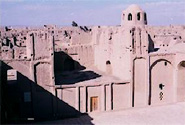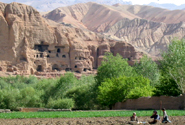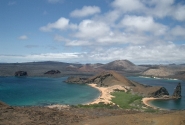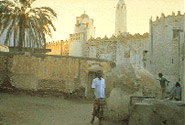Werelderfgoed in gevaar (in het Engels)
World Heritage in Danger
Armed conflict and war, earthquakes and other natural disasters, pollution, poaching, uncontrolled urbanisation and unchecked tourist development pose major problems to World Heritage sites.
Ascertained dangers are those referring to specific and proven imminent threats. Whereas potential dangers refer to cases where a property is faced with threats which could have negative effects on its World Heritage values.
Under the 1972 World Heritage Convention, the World Heritage Committee can inscribe on the List of World Heritage in Danger properties whose protection requires "major operations (...) and for which assistance has been requested".
Inscribing a site on the List of World Heritage in Danger allows the World Heritage Committee to allocate immediate assistance from the World Heritage Fund to the endangered property. It also alerts the international community to these situations in the hope that it can join efforts to save these endangered sites. The listing of a site as World Heritage in Danger allows the conservation community to respond to specific preservation needs in an efficient manner. Indeed, the mere prospect of inscribing a site on this List often proves to be effective, and can incite rapid conservation action.
Currently there are 31 sites inscribed on the list (as of November 2009, see link at the bottom of this page).
Examples of sites inscribed on the List of World Heritage in Danger:

Iranian city of Bam. The ancient Citadel and surrounding cultural landscape of the Iranian city of Bam, where 26,000 people lost their lives in the earthquake of December 2003, was simultaneously inscribed on UNESCO's World Heritage List and on the List of World Heritage in Danger in 2004. Important international efforts are mobilised to salvage the cultural heritage of this devastated city.

Bamiyan Valley in Afghanistan. This cultural landscape was inscribed on the List of World Heritage in Danger in 2003 simultaneously with its inscription on the World Heritage List. The property is in a fragile state of conservation considering that it has suffered from abandonment, military action and dynamite explosions. Parts of the site are inaccessible due to the presence of antipersonnel mines. UNESCO, at the request of the Afghan Government, coordinates all international efforts to safeguard and enhance Afghanistan's cultural heritage, notably in Bamiyan.

Galapagos Islands, Ecuador. The unique ecosystem of the Galapagos Islands is under threat of mass tourism. Cruise ship passengers nowadays spent more than twice as much time on the islands then they used to 15 years ago. Due to tourism, boat traffic between the islands has increased and more people living from tourism have moved permanently to the islands. Another threat is posed by the invasion of alien species into the ecosystem. The World Heritage Convention has inscribed the Galapagos Islands to the List of World Heritage in Danger in June 2007.

Historic Town of Zabid in Yemen. The outstanding archaeological and historical heritage of Zabid has seriously deteriorated in recent years. Indeed, 40% of its original houses have been replaced by concrete buildings. In 2000, at the request of the State Party, the Historic Town of Zabid was inscribed on the List of World Heritage in Danger. UNESCO is helping the local authorities to develop an urban conservation plan and to adopt a strategic approach for the preservation of this World Heritage site.

Manovo-Gounda St Floris National Park, Central African Republic.
The importance of this park derives from its wealth of flora and fauna. Its vast savannahs
are home to a wide variety of species: black rhinoceroses, elephants, cheetahs, leopards,
wild dogs, red-fronted gazelles and buffalo, while various types of waterfowl are to be found
in the northern floodplains.
The site was added to the List of World Heritage in Danger following reports of illegal grazing
and poaching by heavily armed hunters, who, according to some reports, may have harvested as
much as 80% of the park's wildlife.
